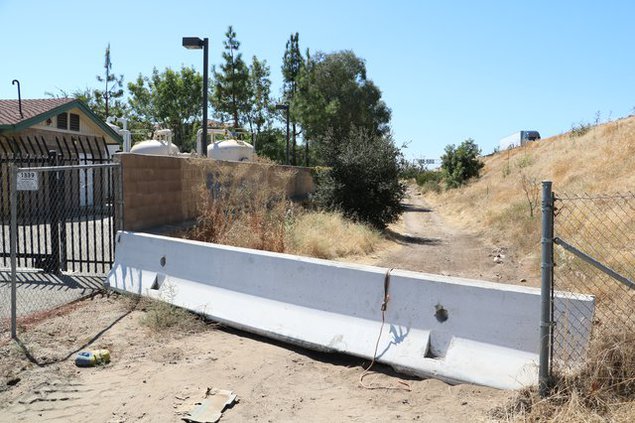Gary Rice has new neighbors — homeless who set up “camp” many nights on the other side of his backyard fence in the municipal parking lot on Powers Avenue next door to the Manteca Fire Station.
Rice told the Manteca City Council Tuesday that the homeless will gather, pull out items from their vehicles and bed down for the night, and often create significant noise.
Given they are next to the masonry sound wall for the Curran Grove neighborhood, the homeless are closer to his house than his neighbors.
He has called police but noted “they can only do what they can.”
It is why he wants the city to post signs prohibiting overnight parking in the lot created a decade ago on an odd municipal parcel to provide more parking for users of Lincoln Park and Manteca Little League fields.
Rice, who made his remarks during the portion of the council agenda reserved for public comments in non-agenda items, said there are sometimes as many as six vehicles driven by homeless that end up in the parking lot some nights.
Dozens of homeless
living in vehicles on
Manteca’s streets
It is not a situation unique to the Powers Avenue parking lot. On any given night — or day — there are dozens of homeless living and sleeping in cars throughout Manteca.
You can find them in parking lots — municipal and those with conditioned public access at commercial centers such as Walmart. Sometimes they are parked in smaller parking lots for the night. They rarely stay in one place long — for a few days at most — before moving on.
They are found on city streets including in neighborhoods where they will often pick somewhat non-obstructive spots such as on East Alameda in front of a vacant lot.
Rice’s frustration also underscores the shortfalls associated with a city approach to homelessness that assumes a two-pronged solution — a navigation center and drop-in shelter — is all that is needed.
And although the emergency shelter now operating in a tent at 555 Industrial Park Drive allows for homeless to stay on the grounds in their vehicles, it is clear that it is only making a dent in the problem.
Whether it is because of lack of knowledge of that option being available or homeless being leery of using it is up for debate.
But one thing is clear there are a lot of homeless living in vehicles in Manteca.
In many instances they will end up spending the night in a specific location that is fairly isolated from neighbors such as the Spreckels Park BMX parking lot and then scatter at dawn.
Mayor Ben Cantu shared with Rice that the council could not respond to his comments apparently based on legal advice from the city attorney regarding the council delving into discussions regarding items that are not noticed as part of a posted agenda.
Court rulings constrain
how city responds
But if Cantu felt he could respond or have appropriate city staff do so, it could have provided an educational moment for the community and give residents a better understanding of what Manteca — as well as other cities — under the jurisdictions of the 9th District Court of Appeals in California, Oregon, Washington, Idaho, Montana, Arizona, Hawaii, and Nevada are up against.
That ruling essentially says homeless can’t be banned from sleeping in public spaces during a reasonably carved out time period which in Manteca has been established as 11 p.m. to 6 a.m. unless there is an available bed in a local shelter they can be directed to.
Other court rulings that have struck down wholesale citywide bans on sleeping in vehicles parked in city streets. That is why cities such as Los Angeles where there are an estimated 10,000 vehicles on the streets that homeless live in have banned such practice and limited the prohibition of sleeping in vehicles to residential streets.
Los Angeles has tried to address the problem with dedicated parking lots with 5,000 spaces for homeless where they can park and live in their vehicles.
Manteca’s illegal camping ordinance formulated as part of a class action lawsuit settlement regarding charges the city was violating the civil rights of homeless only carves out two exceptions to where anyone can “sleep” in vehicles or otherwise on municipal property that is accessible to the general public between 11 a.m. and 6 p.m. Those exceptions are the Manteca Transit Center and the Moffat Community Center/VFW Hall. Any more targeted exceptions such as the parking lot at the Manteca Civic Center runs the risk of the city not being deemed as acting in a reasonable manner in the eyes of a court.
Since all city parks and any off-street parking they include are closed at night and off limits to everyone regardless of housing status they are not considered carve outs in banning sleeping or camping.
The Manteca ordinance essentially eliminates any sleeping on residential sidewalks that are public right-of-way due to the need to keep adequate space for pedestrians to pass. It is why the police can’t currently roost people who encamp on the generous sidewalk that abuts the Manteca Library courtyard on Center Street between 11 p.m. and 6 a.m.
A drop-in shelter could change that assuming there is space available and the police manpower to enforce it.
But as Councilman Charlie Halford pointed out, even if the city today took possession of the 8 acres on South Main Street where the navigation center/drop-in shelter is being pursued, it would take 18 months to 2 years for facilities to open assuming the city fast tracks the projects.
That means unless the city finds interim measures Manteca residents such as Rice are likely to endure homeless issues near where they live for at least two more years before Manteca has put itself in a position where they are able to start working toward a possible effective solution.
To contact Dennis Wyatt, email dwyatt@mantecabulletin.com





